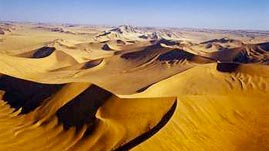Teachers' Domain - Digital Media for the Classroom and Professional Development
User: Preview

Source: Produced for Teachers' Domain
This still collage produced for Teachers' Domain shows different features of deserts across the globe. Some are hot, and others are cold. Some contain rippled sand dunes, while others have rocky landscapes. However, deserts share one trait: all are extremely dry. Their remarkable and unique natural features -- including rolling dunes, wind-sculpted rock, and flat-topped mesas rising from barren plains -- are the result of their dryness.
Scientists often refer to large geographical areas with a distinct set of plants, animals, and climatic conditions as biomes. There are four major terrestrial biomes: forest, grassland, tundra, and desert. Deserts cover about one-fifth of Earth's land area and are found in the driest places on the planet, where annual rainfall totals less than 20 cm (8 in).
Desert landscapes are created and maintained by weathering and erosion. These natural processes gradually break down rocks into smaller particles and then transport the particles across the landscape. The sand and dust are carried away by wind, and in some cases, by runoff from seasonal rainstorms or snowmelt, continuing the erosion of the landscape. Desert landscapes reflect the forces of both erosion and deposition. For example, sand dunes are formed by the deposition of wind-borne material that has been eroded from solid rock by various physical and chemical processes.
Deserts are dry, but they are not entirely devoid of water. Seasonal precipitation may collect on the surface -- although this is generally a temporary situation. Areas in a desert that contain enough water to support plant life on a more or less permanent basis are called oases. Oases usually occur where groundwater stored in underlying rocks seeps to the surface in the form of springs. These springs attract people and animals, and both may settle nearby.
Geological evidence demonstrates that desert areas expand and contract naturally as a result of changes in climate. Fossilized dunes found in sedimentary rock layers in Arizona suggest that inland seas once covered today's desert. Also, whale bones have been discovered in ancient seabeds that underlie sand-covered valleys in Pakistan.
Although the natural expansion of deserts cannot be stopped, desertification brought on by human hands can be. Desertification is the spread of desert-like conditions through the mismanagement of renewable resources, such as grassland. For example, overgrazing by animal stock, wood extraction at desert margins, and maximum-yield farming practices can destroy soil structure and reduce the biological potential of land. As thin soil erodes, the desertification process begins. According to the UN, more than a quarter of the Earth's land surface, which supports 250 million people, is either already affected by the phenomenon or at risk from it.
Like global warming, desertification has been the subject of intense debate among scientists. Some blame local climate change, while others believe that human factors are largely responsible. Whatever its cause, desertification can be slowed or even halted by adopting measures designed to preserve plant cover and reduce soil loss.
 Loading Standards
Loading Standards Teachers' Domain is proud to be a Pathways portal to the National Science Digital Library.
Teachers' Domain is proud to be a Pathways portal to the National Science Digital Library.
